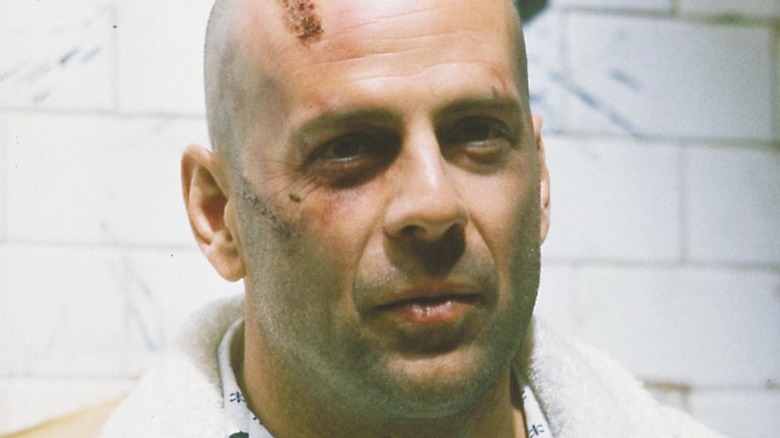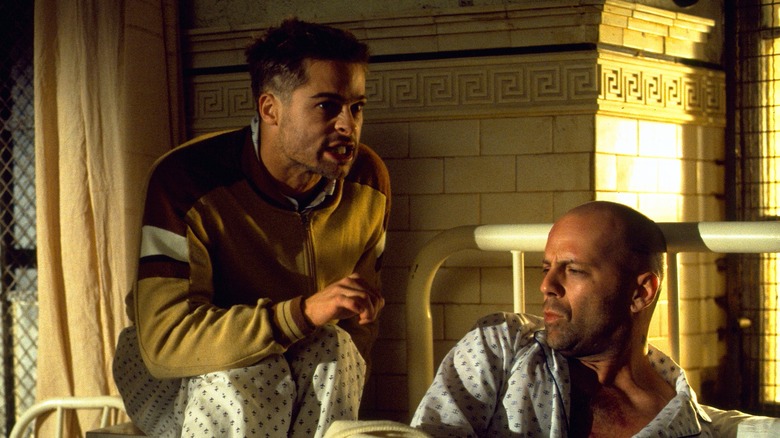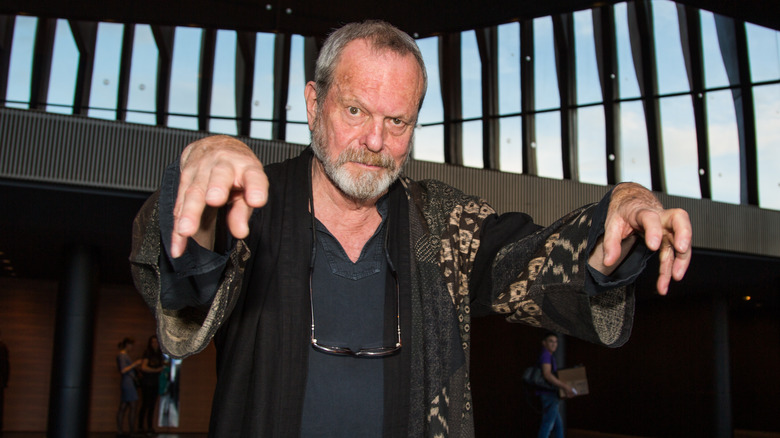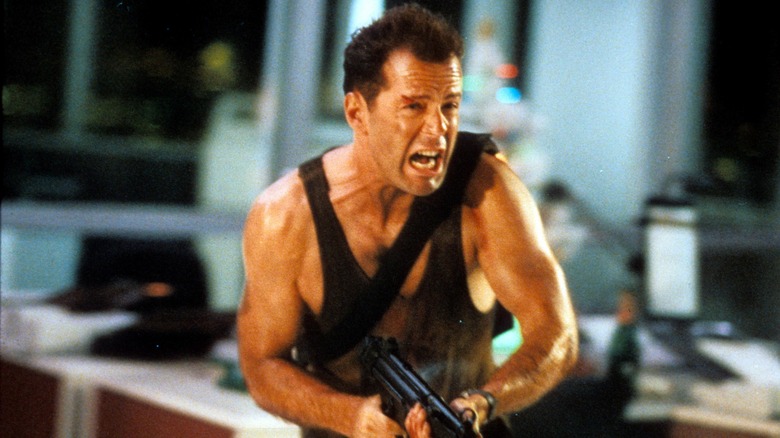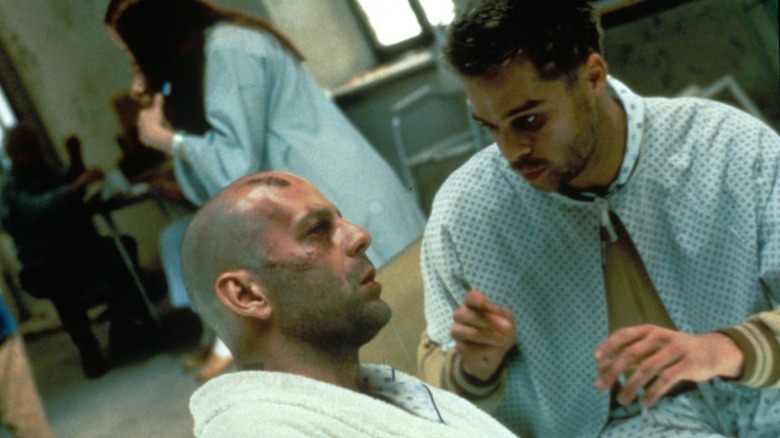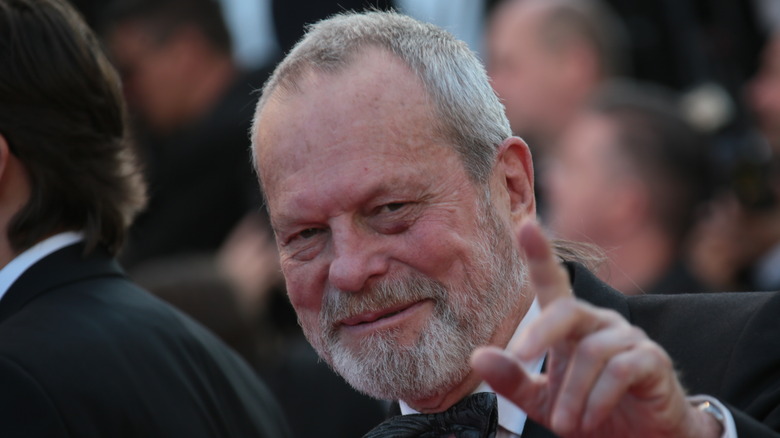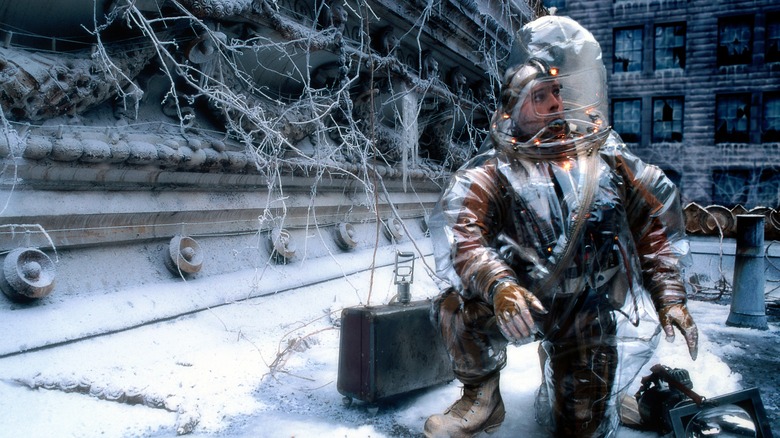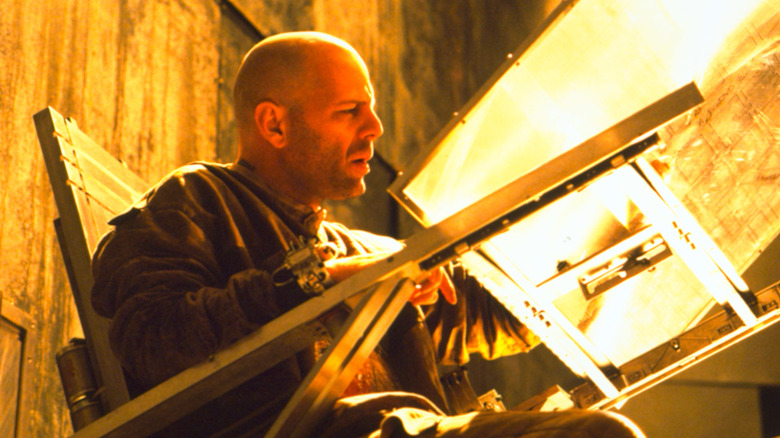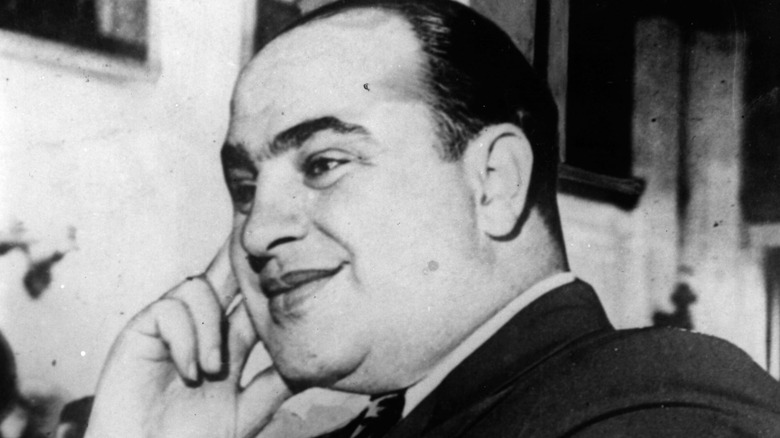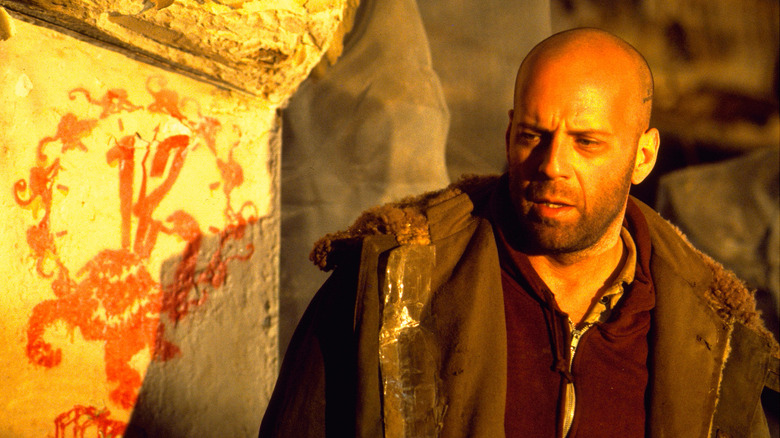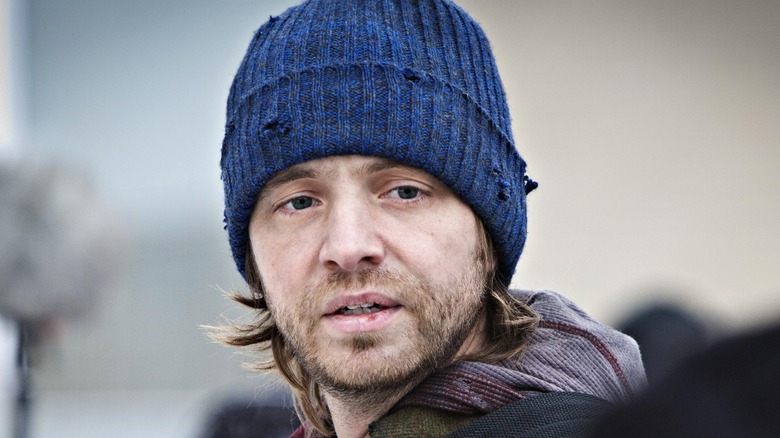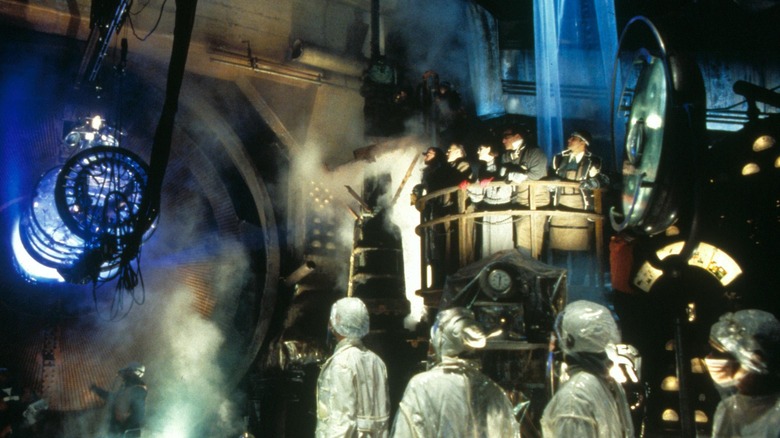The Untold Truth Of 12 Monkeys
Take a pinch of time travel, add a shake of a global pandemic, mix in a subtle flavor of ecological crisis, put in the oven, bake until golden and you have Terry Gilliam's "12 Monkeys." Released in 1996, the movie was an insightful and no-holds-barred view of what humanity's future would look like. Much like "Blade Runner" — which was also scripted by "12 Monkeys" co-writer David Peoples — the future in this movie isn't pretty or Utopian. It's bleak, accusing, and claustrophobic. Both a box office smash and a hit with the critics, "12 Monkeys" refuses to follow formulas or let the viewer off the hook with a happy ending.
With Hollywood heavyweights Bruce Willis and Madeleine Stowe on board, and rapidly rising star Brad Pitt in support, Terry Gilliam was given more freedom by the producers to follow his trademark vision of what a film could be. The collapse of civilization, the Cassandra Syndrome, and questions about preconceived notions of sanity and the paradoxes of time travel are all themes that force the audience to sit up and pay attention. So take a breath, gather your wits and let's take a deep dive into the murk, mist, and mayhem of "12 Monkeys."
It's based on a short French film that Terry Gilliam refused to watch
Before there was "12 Monkeys," there was a short science fiction French film called "La Jetee" (via Films Lie). Directed by Chris Marker in 1962 and composed mainly of still shots, "La Jetee" is a study on the illusion of cinema and the false perception of time that all film conspires to create. The film's plot revolves around a soldier in a post-apocalyptic Paris who is used as a test subject for a series of experiments in time travel. Through clever editing and voice-over commentary, "La Jetee" manages to create a multi-layered 28-minute film about the unreliability of memory, the whimsical nature of time, and how it traps us all in its never-ending labyrinth. It's easy to see the similarities with "12 Monkeys."
David and Janet Peoples were the scriptwriters in charge of adapting "12 Monkeys" from "La Jetee," and, according to Cinephilia and Beyond, both felt it was the perfect film and had initial reservations about its remake. In an interview, Terry Gilliam described "La Jetee" as "technically brilliant." He also equated the film to music or poetry because of the editing, which he coined, "the most extraordinary I have ever seen." Although quick to sing the praises of "La Jetee," Gilliam admitted in an interview with Film Scouts, that prior to, and during the filming of "12 Monkeys" he refused to watch the film. Gilliam explained, "I've never seen "La Jetee." If I do something based on something else I make it a principle not to read or see the original. I'll be intimidated by it or I'll feel an awful sense of responsibility."
Terry Gilliam initially thought 12 Monkeys was too complex to make
When the script for "12 Monkeys" landed on Terry Gilliam's lap, he loved the story that David and Janet Peoples had created. It wore its inspirations unashamedly but it was very much its own beast and blazed its own trail. There was, however, one big problem. In an interview with Den of Geek, Gilliam explained that he felt the movie about time travel, underground civilizations, and deadly viruses that kill all but one percent of the world's population was far too complex to make. Yet fortune favors the brave. With the realization that the studio had already invested a million dollars in the script and wanted to see a tangible return on their money, he threw caution to the wind and picked up the directorial reins.
Gilliam explained, "My job was basically to find a cast to make it work. Once Bruce Willis was on, we were off running, and Brad Pitt was the icing on the cake. And then we made the film." Although Gilliam felt the film's success proved there was an audience for films that engaged the intellect as well as the emotions, he recalled meeting with studio executives who had a different explanation for the film's popularity: Brad Pitt. Gilliam added, "Their reductionist theory of its success was very simple. I was saying, 'Wait!' But of course, that's the way it works." Gilliam explained that post "12 Monkeys," Pitt appeared in a string of failures such as "The Mexican" and "Meet Joe Black." Gilliam elaborated it eventually turned out well for Pitt but insisted that studios should concentrate more on the quality of the film and less on big-name stars and overblown promotion campaigns.
Terry Gilliam was concerned that Bruce Willis's Hollywood tough guy persona was wrong for 12 Monkeys
Although in the mid-nineties, Bruce Willis was riding the crest of a wave and a huge box-office draw, Terry Gilliam initially felt that the Hollywood "tough guy" was the wrong fit for a damaged, vulnerable and confused character such as James Cole. Willis had built his reputation playing wisecracking alpha males such as John McClane in the "Die Hard" franchise, and Gilliam revealed to Inverse that although he liked him as a person he wasn't a fan of Willis as an actor. The director confessed that Nicolas Cage and Tom Cruise were also in the running to play Cole. With pressure to attach a big-name movie star to the production, Gilliam decided to take a punt on Willis because he was smart and funny, and Willis, who was looking to try out more challenging roles, agreed to a pay cut.
Adamant that the superstar meet certain conditions to play the part, Gilliam explained he told Willis how much he hated that, "Pursed-lip expression he does in his films when he gets a little nervous. It's a Trumpian mouth. For a moment it goes all Trumpian. Rectal. It's like I'm looking at somebody's a**hole." Spotlight reported that Gilliam also recalled saying to Willis, "You've got to come here basically naked; you can't come with all the entourage, the trappings of the superstar. This character is basically alone, that's his nature." Gilliam admitted that, to his credit, Willis, "Worked his a**off" because the actor "was desperately feeling he wanted to escape the trap of success."
Brad Pitt worked with a psychiatrist to perfect the role of Jeffery Goines
Playing the part of a neurotic and hyperactive individual whose mouth can barely keep up with his quicksilver thoughts was an opportunity for Brad Pitt to show the world he had serious acting skills to match his good looks. "12 Monkeys" casting director Magery Simkin told Inverse, "With Brad at the time, it was a failure of people's imagination about him. And also the curse of the pretty boy, that people don't believe God gives with both hands or something." Simkin added that the films presented both Pitt and Bruce Willis with an ideal opportunity to push people's perceptions of what they could do as actors. Producer Charles Roven revealed that Pitt was so committed to the role of Jeffery Goines that he spent some time in a ward for people with mental health conditions to gain a fuller understanding of the character.
The New York Times reported that psychiatrists are often dismayed about the reckless and inaccurate way mental disorders are depicted in movies. To avoid falling into that trap, Pitt worked closely with Dr. Laszlo Gyulai, who explained that too often in film, people suffering from mental health difficulties are made to "look like lunatics, but many patients who are mentally ill are not crazy at all, particularly if they have depression or mood disorders." Terry Gilliam revealed he initially thought, Pitt, who won a Golden Globe for the role, might not be able to capture up the mercurial intensity of Goines. He explained, "I was actually scared sh**less that Brad might not be able to do the character because up to then we'd never seen him as a motormouth."
Terry Gilliam stumbled upon 12 Monkeys' haunting musical score by accident
Everything about the "12 Monkeys" — from the set to the dialogue to the direction to the plot and the performances — has a haunting quality that is both unsettling and captivating. The musical score is no different. Suite Punta Del Este composed by Astor Piazzolla has an unrelenting quality like a snake consuming its tail or time collapsing in upon itself. As such it's perfect for a film such as "12 Monkeys." Suite Punta Del Este is played over the main titles and repeated occasionally throughout the film until it becomes like an earworm working its way into the fabric of your soul.
In an interview with Wide Angle/Closeup, Terry Gilliam revealed that his musician friend Ray Cooper recommended he listen to some Argentinian tangos by Carlos Gardel. Gilliam couldn't get his hands on any of the traditional styles of tangos that Gardel was renowned for. Instead, he stumbled across a CD by a guy called Piazzolla. The music stayed with Gilliam and he explained, "I was convinced they were right for the film and I wanted to use them." Yet when he attempted to use them as a soundtrack to certain scenes in the film, such as when Cole and Reilly were in the car, "It just felt like driving music; it didn't work. And I put it somewhere else and I was getting frustrated." And then out of the blue, Gilliam had a eureka moment. "It just hit me — it's the '12 Monkeys' theme."
12 Monkeys features a lot of televisions to express Terry Gilliams' hatred of their stupefying effect
Viewers who pay close attention to "12 Monkeys" will notice that there are a lot of scenes that feature televisions broadcasting everything from news bulletins to cartoons and advertisements. Terry Gilliam is not a big fan of TV and wanted the television sets churning out a steady diet of nonsense to symbolize their narcotic effect. In an interview with Film Scouts, the director explained that television is "ubiquitous in 12 Monkeys" because, "I think television is this awful mirror that we look into every day, but it distorts the reflection and I hate it. It trivializes life. Rather than really enlightening us, it ends up just dragging us down to the lowest, into the boring and the tedious."
The unrelenting wave of television trivia in "12 Monkeys" perfectly encapsulates the insidious and perpetual way that TV slowly bends reality to its will and creates an almost bullet-proof presentation of the way the world was, is, and forever shall be. Gilliam added that he included a big dose of what The Disposable Heroes of Hiphoprisy once called "The Drug of a Nation" in "12 Monkeys" because no matter how hard you try to resist the hypnotic qualities of TV, it eventually lures you into thinking the world works the way the little screen in the room tells you.
The set design was inspired by deconstructionist architecture
As is only fitting for a film that in part deals with the apocalyptic outcome of humanity's hubris, many of the locations in "12 Monkeys" were what Terry Gilliam branded as "cathedrals of technological progress" (via Film Scouts). Disused power stations, factories, and even nuclear plants were scouted out and used for locations in a film that Gilliam described as being about nostalgia and decay. Gilliam said, "These great spaces were considered to be providing the solution, yet now they're just wasted, lying there, rotting." In an interview with Wide Angle/Closeup, production designer Jeffrey Beecroft explained that a lot of the set design on "12 Monkeys" was heavily influenced by deconstructionist architecture.
A book on the architecture of Labbeus Wood proved instrumental in setting the stage for the unique look and atmosphere of "12 Monkeys." Beecroft explained, "He's an artist that no one's ever built anything he's drawn because it doesn't stand up. So I built it! And it doesn't make sense, but it works." Beecroft explained that Gilliam would often say, "Make this Labbeus-looking!" Yet the production designer points out, "To make Labbeus-looking things is very hard, so we used the language of tin, and things we could find that were not real expensive and had really good metal workers, and we just started forming stuff." Art News reported that upon seeing the chair attached to the wall on which Bruce Willis's character is interrogated by the scientists on, Wood saw red and sued Universal. The late conceptual architecture visionary claimed the set was a copyright infringement on his 1987 design Neomechanical Tower (Upper) Chamber. An agreement between Universal and Labbeus was settled out of court.
Al Capone's prison was the location for 12 Monkeys' psychiatric asylum
The psychiatric asylum in "12 Monkeys" where James Cole meets Jeffrey Goines for the first time has a sinister and imitating presence. And that's because the scenes were filmed in America's most historic prison: Eastern State Penitentiary (ESP). Located in Philadelphia, Pennsylvania, the prison opened its doors in 1829 before finally closing in 1971. The ESP is a National Historic Landmark in the U.S. and was famous for housing criminal luminaries such as Al Capone. Solitary Watch reported that in 1842, Charles Dickens was given a tour of ESP and was horrified by the solitary confinement the prisoners had to endure.
In "American Notes for General Circulation," Dickens wrote that prisoners were separated from the living world and buried alive. He believed "very few men are capable of estimating the immense amount of torture and agony which this dreadful punishment, prolonged for years, inflicts upon the sufferers." It was an unusual place to shoot a film and as location manager, Scott Elias pointed out to Inverse, "It (ESP) was supposedly haunted, which I wouldn't doubt. They had a central rotunda and then various cell blocks pin-wheeled out from that center. The whole idea was that the guards could be in the center and could see everything that was going on." In addition to appearing in "12 Monkeys," ESP also features in "Transformers: Revenge of The Fallen" and "Return to Paradise."
Universal gave Terry Gilliam the final cut of 12 Monkeys
Terry Gilliam has always had a reputation as a director who works outside of the Hollywood system and is not afraid to go toe to toe with bigshot studio executives to fight for his vision. Although "12 Monkeys" was more mainstream than anything the director had filmed previously, the studio still considered it a financial risk. To compound matters, Gilliam already had a track record of locking horns with Universal. 10 years earlier, the studio had initially refused to distribute what is widely hailed as Gilliam's masterpiece, "Brazil" (via Ringer). Universal was adamant that unless drastic cuts were made and a happy ending put in place, it would never see the light of day. Gilliam held his ground and eventually Universal agreed to release a slightly shorter version when it was awarded best film, director, and screenplay by the Los Angeles Film Critics Association which had been given secret screenings of "Brazil."
Gilliam feared a similar merry-go-round with "12 Monkeys," particularly when executives began to ponder post-filming if it was perhaps too artistic for a mass audience. Things took a turn for the worse when the feedback of two National Research Group screenings was largely negative. Yet this time the angels were on Gilliam's side in the shape of the movie's big-name stars who backed the director's version of "12 Monkeys." Gilliam explained he always makes allowances "for the big battle at the end" of any film and was pleased to see Brad Pitt, Madeleine Stowe, and Bruce Willis had his back "in the foxhole." He added, "They all stuck together with me, and the studio just couldn't do anything about it."
12 Monkeys launched a spin-off TV series
20 years after it was released, "12 Monkeys" was resurrected for a spin-off TV series that proved a lot more straightforward and conventional than Terry Gilliam's ode to the eternal riddle of time and the finite nature of human perception. The TV show is still set in the future when a virus has decimated humanity and a time traveler called James Cole (Aaron Stanford) buddies up with a doctor to put things right (via The Verge). Yet unlike Bruce Willis's version of Cole which is haunted, ragged, and frayed, the made-for-TV version has superhuman healing and fighting abilities, but little in way of a personality. Emily Hampshire steps gamely into the shoes of Brad Pitt, but compared with Gilliam's strange and sinister original, it all felt a little flat. Yet it still had enough in the tank to run four seasons until it took its final bow in 2018.
Upon hearing the news of the "12 Monkeys" TV spinoff, Gilliam told ScreenDaily that he thought the whole notion was ridiculous and that no one from the show had been in touch with him to discuss any details. He explained, "It's a very dumb idea. That's what I think. If it was going to be any good it would have to be written by David and Janet Peoples, who wrote the film, otherwise, it would be just another version of 'Time Bandits.'"
12 Monkeys made some uncanny predictions
Much like the passing of time, there's beautiful and elusive chaos about "12 Monkeys." As Willis' character James Cole said toward the film's end, "This is the present. This is not the past. This is not the future. This is right now." Yet, little did Terry Gilliam realize way back in 1995, that the world-destroying virus that serves as a backdrop to events in the movie would eventually take on the tone of a prophecy. In 2002, film critic Elvis Mitchell wrote in the New York Times that the biblical floods, plagues, landslides, and heatwaves that were ravaging modern times were like the world catching up with "the lyric paranoid streaks" of Gilliam's imagination. In 2020, the warnings inherent in "12 Monkeys" became even more apparent when Covid-19 broke.
Before the Covid-19 pandemic, Terry Gilliam revealed to Film Scouts that one of "12 Monkeys" themes was, "People putting layer upon layer to protect themselves from a potential infection, end up in a sense isolating themselves from one another." It sounds like a grim prediction of the worldwide lockdowns that followed in Covid's wake. "12 Monkeys" producer Charles Roven told The Ringer, that during the first half of 2020, the film "had a whole new life" as audiences began re-watching a film where life was seemingly imitating art.
